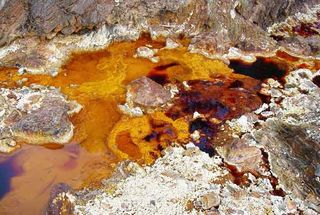Dress Rehearsal for Mars

Beforetesting for life on other planets, it's useful to practice on barren areas ofthe Earth. One such place is Rio Tinto in Spain, where conditions are analogousto Mars.
Thewater of that Spanish river is very acidic, similar to water scientists thinkmay have once flowed on the martian surface. Also, chemical studies hint thatrocks on Mars' Meridiana Planum plain have been moved by Rio Tinto-type water.
Usinglife-searching drilling techniques along the RioTinto river, scientists were surprised to find microscopic life where theythought conditions were too harsh for anything to survive.
Practice makes perfect
Fernando Rull Pérez from the Centro deAstrobiologia in Madrid is an expert in hunting for signs of life usingspectroscopic techniques, and he has been conducting studies in the Rio Tintoregion.
"Weare developing instrument prototypes looking for minerals and organics in RioTinto and other places," he says. "We are also trying to prepare ascientific model with which we can learn about the possibility [of life] andhow we can extrapolate these models to Mars."
Whyis Rull Pérez looking for organicmaterials? They contain carbon, which is present in all known forms oflife. If organics are found it may indicate a type of organism that we wouldrecognize. In other words, life as we know it.
Get the Space.com Newsletter
Breaking space news, the latest updates on rocket launches, skywatching events and more!
Areason Earth like Rio Tinto provide opportunities for scientists to "train"their instruments in the search for organics, and prepare them for similar searcheson Mars. The challenging conditions make for a useful proving ground.Seeing what results from such conditions on Earth may indicate what sort ofunusual minerals we can expect to find on the martian surface.
RullPérez and his colleagues are testing what areknown as "insitu" techniques. That means samples are examined at the sitethere and then, instead of being removed and taken to a lab for analysis.Results are gathered much faster, and it also avoids the problem ofcontamination that can occur during a return journey.
Thespecter of such contamination will likely haunt samples from Mars that arebrought back to Earth for study. But while in situ experiments solve oneproblem, they add another: experiments on Mars must be performed by rovers,millions of miles away from controllers on Earth.
Ready for Mars
RullPérez is working in Rio Tinto on a special insitu tool that will form part of the European Space Agency's ExoMars mission to the RedPlanet, due to launch in 2013. The instrument is known as Raman/LIBS, after thescientist Sir Chandrasekhara Raman, and LIBS for Laser Induced BreakdownSpectroscopy. This tool is a spectrometer that uses a laser to "excite"atoms and molecules. These agitated atoms exhibit more movement than normal,and this atomic dancing can indicate what kinds of molecules are present. It'sa cutting edge system which to date has been almost exclusivelylaboratory-based, so using it in situ is an experiment in itself.
Theinstrument has two optical heads. One located outside the rover will identifyminerals and potential organics on the surface. Another inside the rover willbe used for identification and analysis of core samples excavated by the rover'sdrill. Current plans are to dig down to 2 meters (6.5 feet) beneath the martiansurface. Delving this deep will allow scientists to investigate the possibilityof past or present water — and even life — on the red planet.
TheRaman/LIBS spectrometer has an advantage over other spectrometers because it'snon-destructive: The laser used to probe the matter doesn't cause any harm.This means that it will be deployed before any other instruments on ExoMars.As Rull Pérez says, this instrument will be "onthe front line of identification and analysis." If any organic material isfound, then ExoMars's other gadgets will swing into action and probe thesamples to gather as much data as possible.
Evenas Rull Pérez's Raman/LIBS spectrometer isbeing tested for use on ExoMars, work is underway inside his group on the nextgeneration of the instrument which could probe samples up to 65 feet (20 meters)away. Unlike Rull Pérez's contact spectrometer,this updated version won't be ready for ExoMars — although it may feature onfuture missions. It's an exciting time for astrobiologists searching for life,and in situ instruments tested in RioTinto are at the forefront of their endeavors.
- Video: Life on Mars — The Search Continues
- Life Found Where You Least Expect It
- Unlocking Martian Rocks
Join our Space Forums to keep talking space on the latest missions, night sky and more! And if you have a news tip, correction or comment, let us know at: community@space.com.

Lee Pullen is a science writer and communicator from the city of Bristol, UK. He has a degree in Astronomy and a master’s in Science Communication. He has written for numerous organizations, including the European Space Agency and the European Southern Observatory. In his spare time Lee enjoys taking photos of the night sky, and runs the website Urban Astrophotography.
